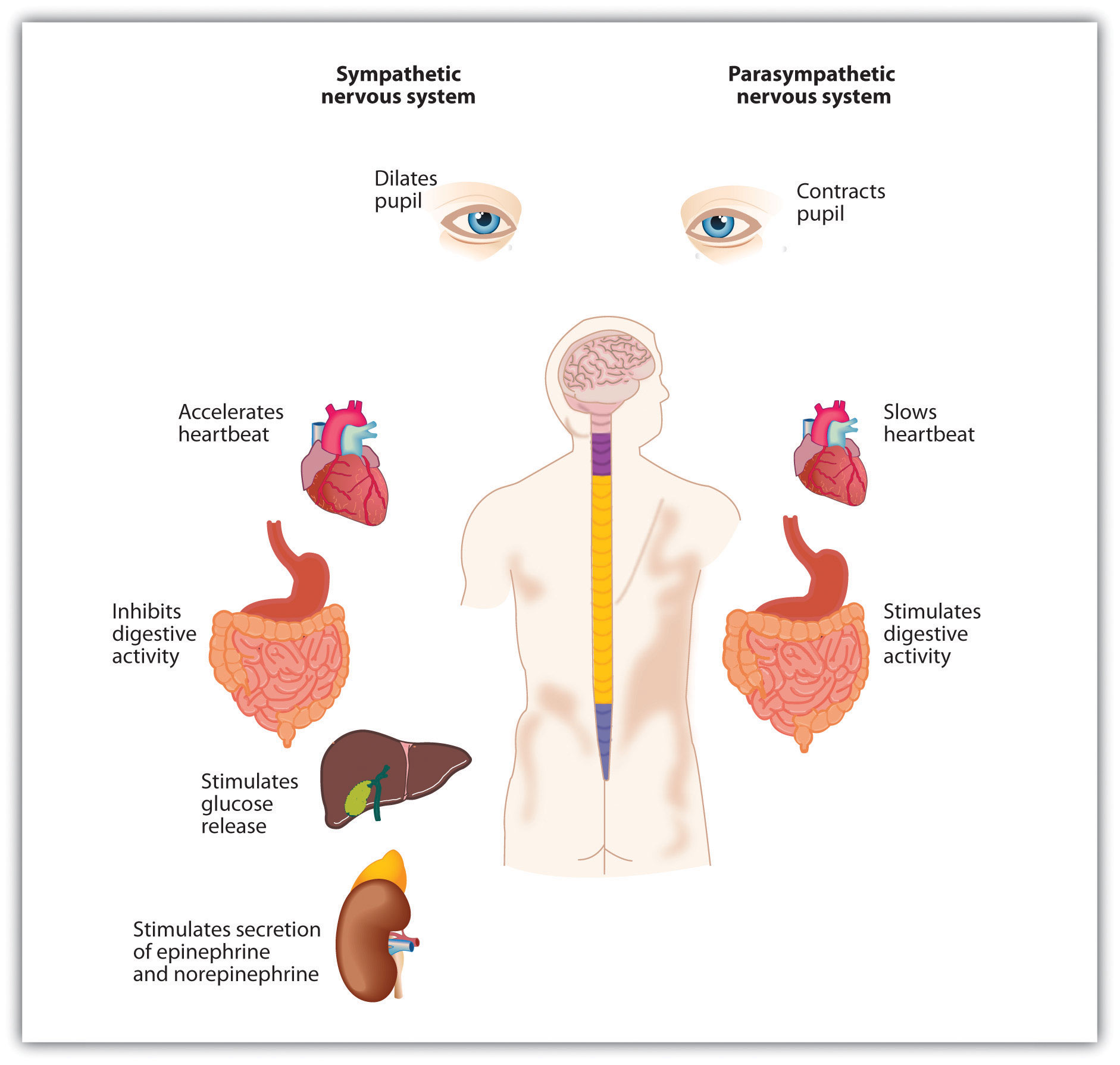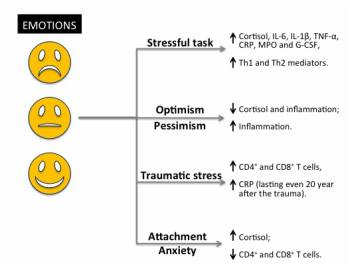Introduction
Emotions are central to human experience, influencing cognition, behavior, and physiological responses. Modern research in affective neuroscience has revealed that there is a complex biological basis of emotions mediated by the autonomic nervous system (ANS), endocrine system, and immune system. These biological systems regulate emotional responses, stress adaptation, and social behaviors.
Read More- Cerebral Lateralisation and Emotions
1. The Autonomic Nervous System (ANS)
The Autonomic Nervous System (ANS) is the body’s rapid-response system that controls physiological changes associated with emotions. It is divided into-

Important Components of PNS for Emotions
A. Sympathetic Nervous System (SNS)
- The SNS is activated in response to emotional stress, preparing the body for action.
- It releases norepinephrine and epinephrine (adrenaline) from the adrenal medulla, which increases heart rate, respiration, and blood flow to muscles.
- Fear and anger strongly activate the SNS, leading to a heightened state of arousal.
Studies on SNS Activation in Emotions-
- LeDoux (1996) found that the amygdala (the brain’s fear center) directly stimulates the SNS during fear responses before conscious awareness occurs.
- Lang et al. (1993) demonstrated that people experiencing fear or anger show increased heart rate, pupil dilation, and skin conductance due to SNS activation.
B. Parasympathetic Nervous System (PNS)
- The PNS restores balance by counteracting SNS activation, slowing the heart rate, reducing blood pressure, and promoting relaxation.
- Positive emotions such as love, happiness, and gratitude activate the PNS, leading to calmness and contentment.
Studies on PNS Activation in Emotions:
- Porges (2003) introduced the Polyvagal Theory, explaining how the vagus nerve supports social bonding and emotional regulation.
- Fredrickson (2001) found that positive emotions broaden cognitive flexibility, reducing stress and promoting PNS activation.
Thus, the ANS ensures survival by quickly mobilizing resources for action during stress while also restoring balance after the threat has passed.
2. The Endocrine System
The endocrine system releases hormones into the bloodstream that influence mood, motivation, and stress responses. The hypothalamus and pituitary gland regulate hormone production through a feedback mechanism.

Endocrine System and Emotions
Key Hormones Involved in Emotional Regulation
- Cortisol (Stress Hormone)- Released by the adrenal glands, cortisol helps the body respond to stress but can cause anxiety and depression if chronically elevated (Sapolsky, 2004).
- Oxytocin (Bonding Hormone)- Produced in the hypothalamus, oxytocin fosters trust, love, and social bonding (Kosfeld et al., 2005).
- Testosterone (Aggression and Dominance)- Higher testosterone levels are associated with increased risk-taking and aggression (Archer, 2006).
- Dopamine and Serotonin (Mood Regulators)- Dopamine regulates pleasure and motivation (Schultz, 1998). Serotonin contributes to emotional stability and social behavior (Young, 2007).
Hormonal Influence on Emotions
- Kirsch et al. (2005) used fMRI to show that oxytocin reduces amygdala activity, reducing fear and promoting social trust.
- Taylor et al. (2000) found that men under stress exhibit a fight-or-flight response, while women release higher oxytocin levels, promoting a “tend-and-befriend” response.
3. The Immune System
The immune system and emotional health are closely linked. Psychological stress can weaken immune function, making individuals more susceptible to illness. Chronic stress, for example, leads to prolonged release of cortisol, which suppresses immune responses and increases vulnerability to diseases (Reeves, 2017)
Moreover, inflammation caused by immune system activation has been linked to mood disorders such as depression and anxiety. Cytokines, the signaling molecules of the immune system, influence brain activity and emotional regulation. Increased levels of inflammatory cytokines have been associated with depressive symptoms, suggesting a strong connection between immune health and emotional well-being.

Emotions and Immune Response Retrived from https://www.affectiveimmunology.com/
Cytokines and Emotional Disorders
- Dantzer et al. (2008) found that increased inflammatory cytokines (IL-6, TNF-α) are linked to depression and fatigue.
- Miller et al. (2009) showed that chronic stress suppresses immune function, making individuals more prone to infections and mood disorders.
- Raison et al. (2013) found that anti-inflammatory drugs can reduce symptoms of depression, highlighting the immune system’s role in emotional health.
Specific Types of Emotions and Biological Basis
Emotions can be broadly divided into positive, negative, and complex emotions. Each of these types has a complex biological basis behind them.
1. Positive Emotions
Positive emotions, such as happiness, love, and gratitude, are associated with parasympathetic activation, oxytocin release, and increased dopamine production.
- Fredrickson (1998) proposed the “Broaden-and-Build Theory,” which suggests that positive emotions expand cognitive flexibility and improve problem-solving abilities.
- Davidson et al. (2003) found that individuals with greater left prefrontal cortex activity experience higher levels of happiness.
2. Negative Emotions
Negative emotions, such as fear, anger, and sadness, are linked to sympathetic activation, cortisol release, and heightened amygdala activity.
- LeDoux (2000) demonstrated that the amygdala processes fear faster than the cortex, triggering immediate defensive responses.
- Gross & Levenson (1997) found that emotion suppression (e.g., hiding anger) leads to increased physiological stress, proving that managing emotions is crucial for mental health.
3. Complex Emotions
Complex emotions, such as guilt, shame, pride, and jealousy, involve both subcortical structures (amygdala, hypothalamus) and cortical regions (prefrontal cortex, anterior cingulate cortex).
- Takahashi et al. (2009) used fMRI to show that jealousy activates the anterior cingulate cortex, which is involved in social comparison.
- Beer et al. (2003) found that the orbitofrontal cortex is essential for experiencing and regulating embarrassment.
Conclusion
The biological bases of emotions involve a complex interplay between the autonomic nervous system, endocrine system, and immune system. These systems regulate physiological responses to emotions, stress, and social interactions. Understanding their roles enhances our ability to manage emotional well-being through stress reduction, social support, and lifestyle adjustments.
References
Reeve, J. (2017). Understanding Motivation and Emotion (7th Edition). Wiley
Davidson, R. J. et al. (2003). “The role of the prefrontal cortex in approach and withdrawal motivation.” Science, 299(5608), 1235-1239.
Ekman, P., Levenson, R. W., & Friesen, W. V. (1983). “Autonomic nervous system activity distinguishes among emotions.” Science, 221(4616), 1208-1210.
Fredrickson, B. L. (1998). “What good are positive emotions?” Review of General Psychology, 2(3), 300-319.
LeDoux, J. E. (2000). “Emotion circuits in the brain.” Annual Review of Neuroscience, 23, 155-184.
Sapolsky, R. M. (2004). Why Zebras Don’t Get Ulcers. Henry Holt and Co.
Subscribe to Careershodh
Get the latest updates and insights.
Join 16,458 other subscribers!
Niwlikar, B. A. (2025, April 7). Biological Basis of Emotions- 3 Important Systems. Careershodh. https://www.careershodh.com/biological-basis-of-emotions/
